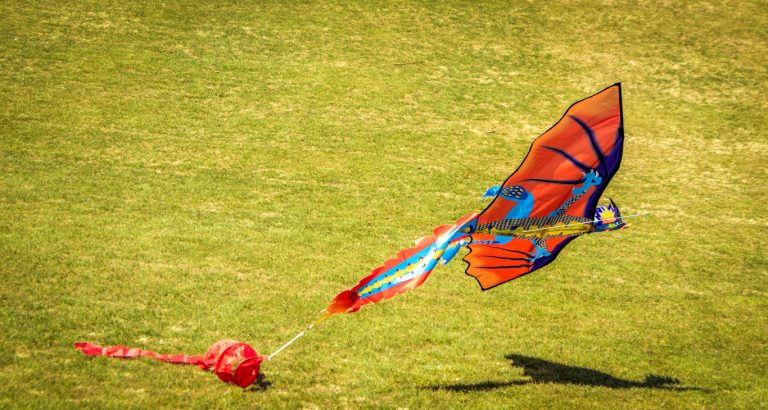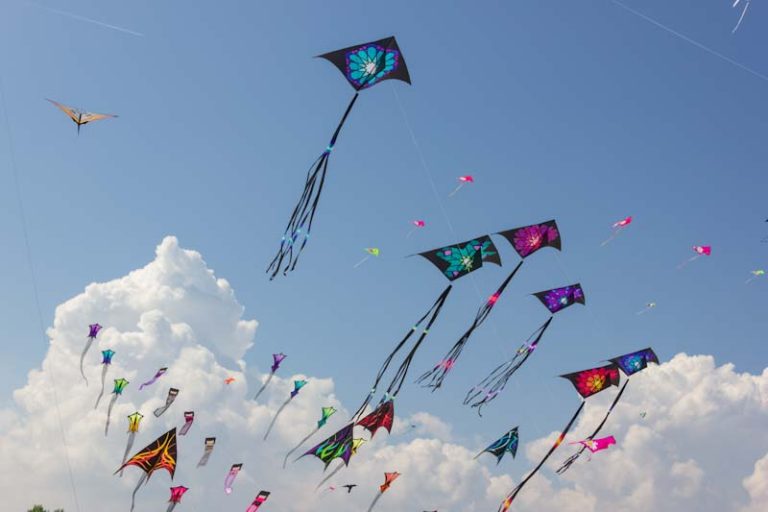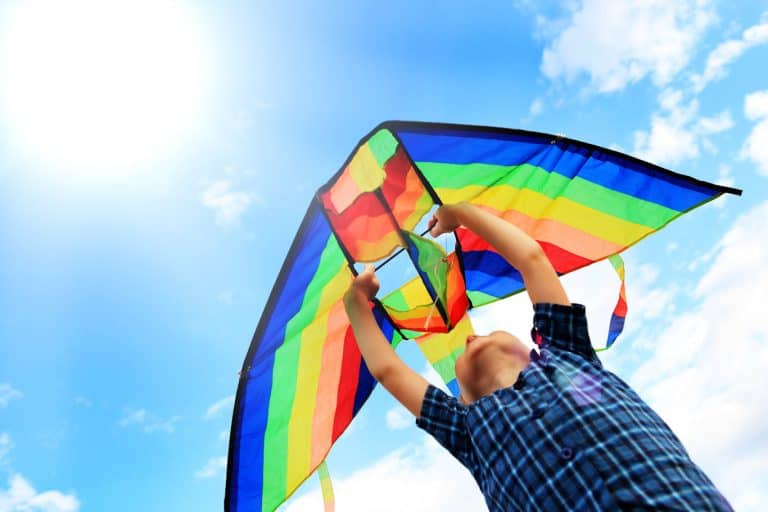The Best Months To Fly Your Kite (And More)
Are you interested in finding the best time to take your kite out? This article discusses different weather, seasons, and the best months to take out one’s kite.
Favorable wind conditions play a prominent role in the success of kite flying. October usually has steady winds making it perfect for kite flying.
What Is The Best Time To Fly Your Kite?
Various kite festivals in the US happen every year, proving that many states practice kite flying. It allows kite fliers to take their kites out and enjoy the outdoors. Also, particular regions within the country have the best flying spots. These include; the Jersey shore, San Francisco, the Tampa Bay area, Lake Michigan Beachfront Park, Cleveland, and the Long Beach peninsula (Source).
The Jersey shore is known for sport kiting, and Grand Haven in Michigan is known for its annual (every May) kite festival that attracts kite operators from all around North America. Most of these kiting activities occur during spring break, even though the older kite fliers sometimes dominate.
During an interview with USA Today, the American Kite fliers’ Association president (John Barresi) spoke of how kite flying brought about peace and the opportunity to stay healthy while enjoying the outdoors. He mentioned that spring breezes in April saw a lot of kites in the air.
In Washington state, however, things are a little bit different. A week-long kiting event that sees thousands of spectators and famous kite fliers from around the globe attend is held in the third week of August (Source).
The Washington state international kite festival lasts for an entire week running from Monday to Sunday. Spectators who watch the professional kite fliers also carry their kites and enjoy the wind.
Many believe that the best time to fly kites is during March and April during spring. After the cold of winter, the weather is most likely warmer; alongside longer days experienced, it is perfect for kite flying. However, in Minnesota, the winter’s snow may last longer on the landscape, but parents still take the kids’ kites flying (Source).
The truth is that dedicated kite fliers can be found operating kites in different seasons. However, fall and spring are the best times to fly these kites for most people. It is to be free from the chilly weather of winter and the scorching temperatures during summertime (Source).
However, there is no denying that October would be an ideal time to fly kites in the United States. It is because of the favorable temperatures and the constant winds. Also, winds are steadier in the fall than during spring.
Which Is The Best Month To Fly Your Kite?
There are four main reasons why October is the best time to fly a kite. They include favorable weather conditions, adequate kite flying space, support family time, and it’s the last chance to do so before winter begins.
Favorable Weather Conditions
During fall, you can be sure that the weather will stay great for the most part. It only changes when the season is almost over. Fall temperatures are pleasant when compared to that summer. The mornings may be slightly chilly, but this in no way affects the weather, and one can comfortably enjoy the outdoors.
On the other hand, Spring weather can be hot at one point, and it may start raining suddenly. That said, there are still chances of rain. For the most part, however, one can expect great weather.
Adequate Kite Flying Space
It means that kite fliers won’t have to compete for kite flying spaces. More people take their kites out in spring than in fall. It is evident in the various kite-flying festivals conducted during spring (Source).
Positive characteristics of kite flying spaces include wide-open spaces free of obstacles such as buildings and trees. Also, they should be far from power lines to prevent kites from getting stuck. Ideal areas include the beach, parks, and farms.
While it’s great that many people come out to kite fly during spring, it poses a risk, with accidents highly likely to happen. One of the essential safety precautions to observe is to fly at a distance from spectators and other kite fliers; it only is expected during kite fighting.
But even when kite fighting, caution is expected as it can cause injuries to spectators or motorcyclists. A lack of adequate space can cause kites to tangle in normal kite flying. It immediately takes the fun out of kite flying.
Fortunately, during fall, you can freely fly your kite without being constantly concerned about the safety of others. Also, you can let out more lines and try different tricks.
Supports Family Time
Kite flying is an excellent sport for both kids and adults. Fall provides the opportunity for families to get together and fly kites. It is a great time to bond with family, and it also offers various teachable moments.
Early fall, in particular, school schedules aren’t as intense and don’t involve loads of work. It makes it easy to take kids on weekends. The great weather will also support a lightly packed kiting bag. Summer months would have you carrying loads of water and sunscreen because of the temperatures.
It’s The Ideal Season Before Winter
Winter entails icy weather and plunging temperatures. Of all the seasons, it is the coldest, and it causes people to prefer staying indoors. It means that undertaking kite flying activities would be challenging. Also, there are spacious areas such as parks that close down during winter, minimizing the possible areas one can kite in.
While it isn’t entirely impossible to fly kites during winter, the number of clothes one has to wear to enjoy the outdoor for long periods can be exhausting.
The main factor for flying a kite is wind, and it can happen regardless of month or season, as long as the wind is available.
Best Wind Speed For Kite Flying
For one to fly a kite, wind speeds are essential factors to consider before going out. Every kite flyer will have a preferred wind speed. It will depend on the type of kite in use or the experience of the kite flier.

Beginners, for example, shouldn’t start kite flying at very high wind speeds. Kites will launch with wind speeds of about 5-7 knots or 9.2-13km/h. the minimum wind speed will change with the different kite sizes.
The surroundings one is in can help determine if the wind speeds are adequate for kite flying. Are the flags in the area flapping? Are the leaves on trees rustling? Keep in mind that highly light wind can prevent kites from launching, and powerful winds can blow away kites or cause lines to snap (Source).
As a rule of thumb, large-sized and heavy kites should fly in strong winds for normal kite flying, and light winds are more suitable for smaller kites. You can’t really fly a kite without wind.
Best Weather To Fly A Kite
Essentially, the wind is the most crucial factor in kite flying. Without it, kites would not fly. It means that kites can fly regardless of the weather, provided winds are available. However, take utter caution during thunderstorms, lightning, and heavy rains.
There is difficulty in flying kites when it’s raining. Operating the kite will be tedious with the rain pouring down as vision and control are challenging. Also, this may prove dangerous to the kite flyer as kites behave like power cords when wet. Also, nylon kite lines are attracted to electricity.
Benjamin Franklin conducted an experiment in 1752 that included taking a kite out during a thunderstorm.
Benjamin and William Franklin, father, and son, started the kite experiment phenomena.
The two wanted to determine electricity and lightning’s true nature. He used a key and collected charge inside a jar. With this, he proved the relation between electricity and lightning. Therefore, it is best to avoid accidents if kites are left indoors during such weather (Source).
It’s also safer to fly kites during the day than at night. During the day, you can see where you are playing with your kite. You can steer clear of obstacles such as trees and power lines. It will also prevent you from stumbling and falling due to rocks or holes. Kites with lights should are imperative if you are trying to fly kites in the night sky.
With that said, the ideal weather also varies from one individual to another. Experienced kite flyers would want to fly in stronger winds than beginners. Kites that require stronger winds (12.87-40.23km/h) include box kites. Delta kites and diamond kites can fly in light or moderate winds (8.04-19.31km/h)
Can I Fly A Kite Today?
Before taking a kite out, it’s essential to determine the wind conditions of the local kiting area by checking weather apps. It is beneficial to travel to a different location to fly your kite.
It would be unfortunate if there were an expected storm in the area you hoped to kite in, as this would be inconvenient and dull the kite-flying session. By checking wind conditions, one can determine if it is ideal and safe to take the kite out.
Generally speaking, the three factors considered when flying kites are winds, precipitation, and temperatures. The perfect winds should be steady instead of gusty. It will help in keeping the kite stable and floating in the sky. Rainfall makes kite flying more difficult and dangerous than it needs to be (Source).
While it may look trivial, temperatures also play a prominent role when kite flying. It is why the ideal kite-flying seasons are fall and spring. Trying to fly in hot temperatures can be uncomfortable. Trying to look at one’s kite can also be hindered by the hot sun.
Some winds require almost no wind and only rely on apparent wind to fly. Such kites fly indoors. One only needs to walk around (Source).
When winds are too strong, kites can produce lift. It is especially possible if they are flying large-sized kites. Weather will, therefore, have a significant say in whether you can use a kite on a particular day.
Other factors that one should consider before flying a kite other than the day include locations and regions. There are limits on how high one can use their kite in specific areas. Flying high near airports can affect how well air crafts can fly (Source).
There has been a ban on particular kite lines in other regions, such as New Delhi. After such lines have proved to be harmful to birds and human life repeatedly, it means conducting prior research on new areas and locations before kite flying is necessary. It is to avoid run-ins with the law.
Delhi police seized many illegal Manja in a raid right before the country’s Independence Day. PETA (People for the Ethical Treatment of Animals) complained about the effects of the Manja string. Similar actions have been taken in other regions as well.
How To Fly Kite In Low Wind?
The type of kite used while kite flying is essential. The variety of kites used directly impacts the success of a kite flying session. It would be best to be meticulous in purchasing kites instead of picking the first one.
You need to observe the construction and design. Differences that can occur in kites include:
- Being heavy or too light.
- Being unbalanced.
- Being inappropriate for various conditions.
Such issues will, in turn, affect a kite’s flying abilities causing it to fly very high or low, turning and diving into the ground or spinning.
You can also make corrections and alterations to improve the sessions. Sometimes the changes to the surroundings should happen, and other times, the kite will need moderation. Add tails to the kites to increase drag, increase or decrease kites bowing, and adjust tow points on keel or harness.
Wind conditions also affect how well kites fly. Steady, moderate winds are better when flying kites. Gustier winds can be challenging. Also, with very high or low currents, there will be a failure to launch kites or crash shortly after taking off.
It is essential to check the wind conditions before flying a kite, as not all days are ideal. Beginners will struggle to get kites in the air with very little wind. However, this can be easier with light kites as some kites require very little wind. Experienced kite fliers will have fewer issues when launching (Source).
Kite flying can be both indoors and outdoors. Kites used indoors are windless kites, zero wind kites, or low wind kites. Such kites can comfortably fly in windless environments.
Such kites suit indoor use. Insufficient winds make it difficult to fly these kites traditionally, but it does not restrict their outdoor use. Motions created by the kite flyer ensure the kite takes off. Such movements include slowly moving backward in circles (Source).
During spring, gustier winds prevail. It increases the likelihood of kites crashing. There must be caution when flying kites during this time. In the summertime, there is very little wind. Sometimes no wind at all is experienced. Together with no wind, the scorching sun makes it difficult to go kite flying.
During winter, there is a wind that provides room for kite flying. However, such winds accompany precipitation that impairs one’s vision. Properly controlling the kite becomes difficult, which can lead to its damage.
Fall, however, has been known to have steady winds that don’t lean much to an extreme (high or low). It makes flying, launching, and retrieving the kite easier.
Summary
Dedicated kite flyers can make kites out no matter the season; however, spring and fall are the most favorable season to fly kites. October is recommended as a great kite flying time as it has good weather and allows families to kite together.







